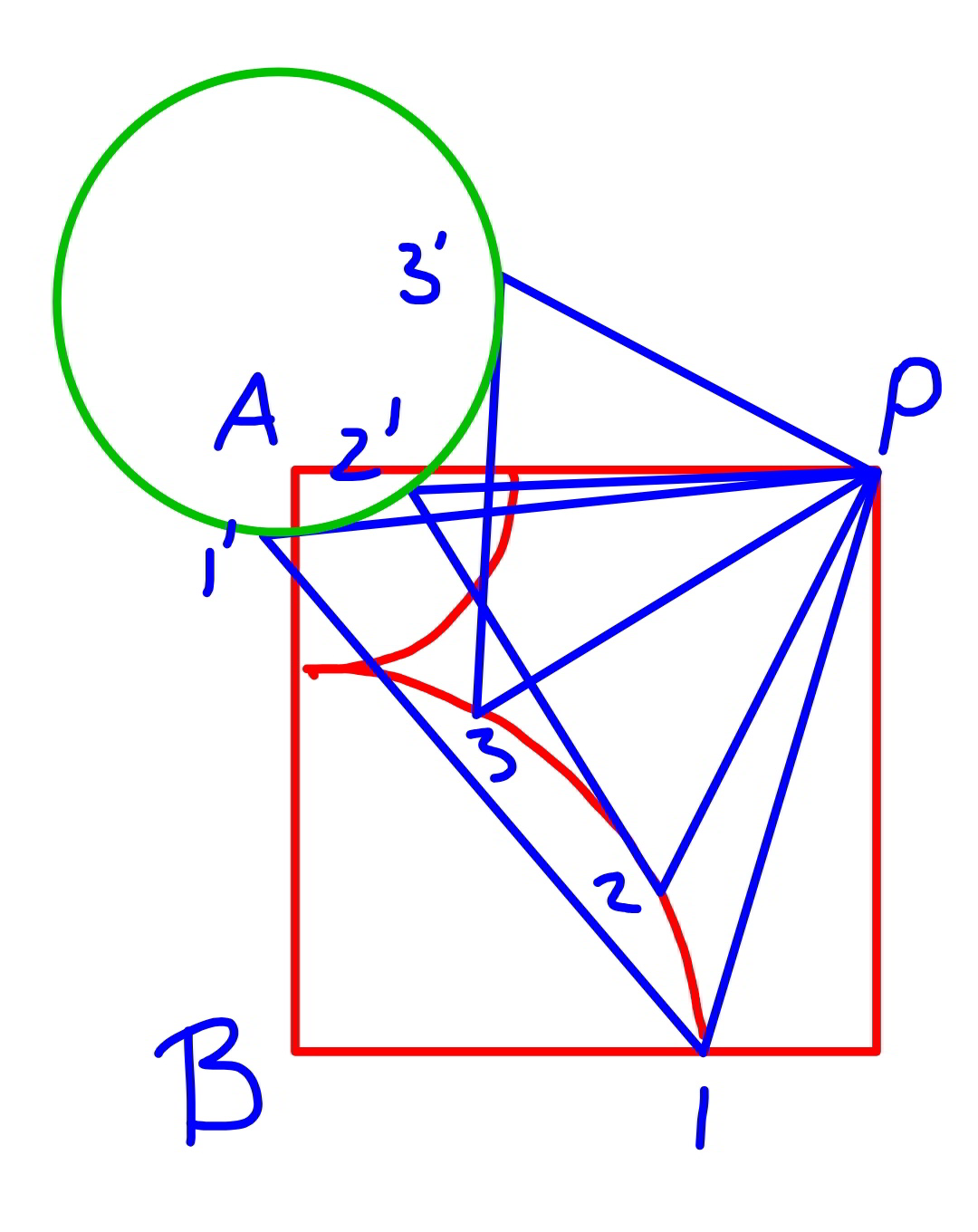
Question Number 70452 by ajfour last updated on 04/Oct/19

Commented by ajfour last updated on 04/Oct/19

$${ABCD}\:{is}\:{a}\:{square}.\:{Find}\:{minimum} \\ $$$${side}\:{length}\:\boldsymbol{{s}}\:{of}\:{equilateral}\:\bigtriangleup{DEF} \\ $$$${in}\:{terms}\:{of}\:{quarter}\:{circle}\:{radii} \\ $$$${a}\:{and}\:{b}.\:{Also}\:{find}\:{range}\:{of}\: \\ $$$$\:\frac{{a}}{{b}}\:{so}\:{that}\:{such}\:{an}\:{equilateral} \\ $$$${triangle}\:{be}\:{certainly}\:{possible}. \\ $$
Commented by MJS last updated on 05/Oct/19

$$\mathrm{I}\:\mathrm{tried}\:\mathrm{with}\:\mathrm{coordinate}\:\mathrm{method} \\ $$$${A}=\begin{pmatrix}{\mathrm{0}}\\{\mathrm{1}}\end{pmatrix}\:\:{B}=\begin{pmatrix}{\mathrm{0}}\\{\mathrm{0}}\end{pmatrix}\:\:{C}=\begin{pmatrix}{\mathrm{1}}\\{\mathrm{0}}\end{pmatrix}\:\:{D}=\begin{pmatrix}{\mathrm{1}}\\{\mathrm{1}}\end{pmatrix} \\ $$$${E}=\begin{pmatrix}{{a}\mathrm{cos}\:\alpha}\\{\mathrm{1}+{a}\mathrm{sin}\:\alpha}\end{pmatrix}\:\:{F}=\begin{pmatrix}{\left(\mathrm{1}−{a}\right)\mathrm{cos}\:\beta}\\{\left(\mathrm{1}−{a}\right)\mathrm{sin}\:\beta}\end{pmatrix} \\ $$$$\mid{DE}\mid=\mid{EF}\mid=\mid{FD}\mid \\ $$$$\mathrm{easily}\:\mathrm{leads}\:\mathrm{to} \\ $$$${a}=\frac{\mathrm{1}−\left(\mathrm{sin}\:\beta\:+\mathrm{cos}\:\beta\right)}{\mathrm{1}−\left(\mathrm{cos}\:\alpha\:+\mathrm{sin}\:\beta\:+\mathrm{cos}\:\beta\right)} \\ $$$$\mathrm{then}\:\mathrm{I}\:\mathrm{put} \\ $$$$\alpha=\mathrm{2arctan}\:{t} \\ $$$$\beta=\mathrm{2arctan}\:{u} \\ $$$$\mathrm{which}\:\mathrm{leads}\:\mathrm{to} \\ $$$${t}^{\mathrm{4}} −\frac{\mathrm{8}{u}\left({u}−\mathrm{1}\right)^{\mathrm{2}} \left(\mathrm{3}{u}−\mathrm{1}\right)}{\left(\mathrm{3}{u}^{\mathrm{2}} −\mathrm{1}\right)\left(\mathrm{5}{u}^{\mathrm{2}} −\mathrm{4}{u}+\mathrm{1}\right)}{t}^{\mathrm{3}} −\frac{\mathrm{2}\left(\mathrm{7}{u}^{\mathrm{4}} −\mathrm{4}{u}^{\mathrm{3}} −\mathrm{2}{u}^{\mathrm{2}} +\mathrm{4}{u}−\mathrm{1}\right)}{\left(\mathrm{3}{u}^{\mathrm{2}} −\mathrm{1}\right)\left(\mathrm{5}{u}^{\mathrm{2}} −\mathrm{4}{u}+\mathrm{1}\right)}{t}^{\mathrm{2}} −\frac{\mathrm{8}{u}\left({u}−\mathrm{1}\right)^{\mathrm{2}} \left({u}+\mathrm{1}\right)}{\left(\mathrm{3}{u}^{\mathrm{2}} −\mathrm{1}\right)\left(\mathrm{5}{u}^{\mathrm{2}} −\mathrm{4}{u}+\mathrm{1}\right)}{t}−\frac{\left({u}^{\mathrm{2}} +\mathrm{1}\right)\left({u}^{\mathrm{2}} −\mathrm{4}{u}+\mathrm{1}\right)}{\left(\mathrm{3}{u}^{\mathrm{2}} −\mathrm{1}\right)\left(\mathrm{5}{u}^{\mathrm{2}} −\mathrm{4}{u}+\mathrm{1}\right)}=\mathrm{0} \\ $$$$\mathrm{and}\:\mathrm{we}\:\mathrm{can}\:\mathrm{solve}\:\mathrm{this}! \\ $$$${t}_{\mathrm{1}} =\frac{\left(\mathrm{3}+\mathrm{2}\sqrt{\mathrm{3}}\right){u}^{\mathrm{2}} −\mathrm{2}\left(\mathrm{1}+\sqrt{\mathrm{3}}\right){u}+\mathrm{1}}{\mathrm{3}{u}^{\mathrm{2}} −\mathrm{1}} \\ $$$${t}_{\mathrm{2}} =\frac{\left(\mathrm{3}−\mathrm{3}\sqrt{\mathrm{2}}\right){u}^{\mathrm{2}} −\mathrm{2}\left(\mathrm{1}−\sqrt{\mathrm{3}}\right){u}+\mathrm{1}}{\mathrm{3}{u}^{\mathrm{2}} −\mathrm{1}} \\ $$$${t}_{\mathrm{3},\:\mathrm{4}} =−\frac{{u}^{\mathrm{2}} +\mathrm{2}{u}−\mathrm{1}}{\mathrm{5}{u}^{\mathrm{2}} −\mathrm{4}{u}+\mathrm{1}}\pm\frac{\mathrm{2}{u}\left({u}−\mathrm{1}\right)}{\mathrm{5}{u}^{\mathrm{2}} −\mathrm{4}{u}+\mathrm{1}}\mathrm{i} \\ $$$$\mathrm{I}'\mathrm{m}\:\mathrm{running}\:\mathrm{out}\:\mathrm{of}\:\mathrm{time},\:\mathrm{please}\:\mathrm{try}\:\mathrm{to}\:\mathrm{continue} \\ $$
Commented by mr W last updated on 05/Oct/19

Commented by mr W last updated on 05/Oct/19

$${a}\:{geometrical}\:{consideration}: \\ $$$${the}\:{green}\:{circle}\:{can}\:{intersect}\:{with}\:{the} \\ $$$${smaller}\:{quarter}−{circle}\:{at} \\ $$$$−\:{no}\:{point}\:\Rightarrow\:{no}\:{solution} \\ $$$$−\:{one}\:{point}\:\Rightarrow\:{one}\:{solution} \\ $$$$−\:{two}\:{points}\:\Rightarrow\:{two}\:{solutions} \\ $$
Answered by mr W last updated on 10/Oct/19

Answered by ajfour last updated on 04/Oct/19

